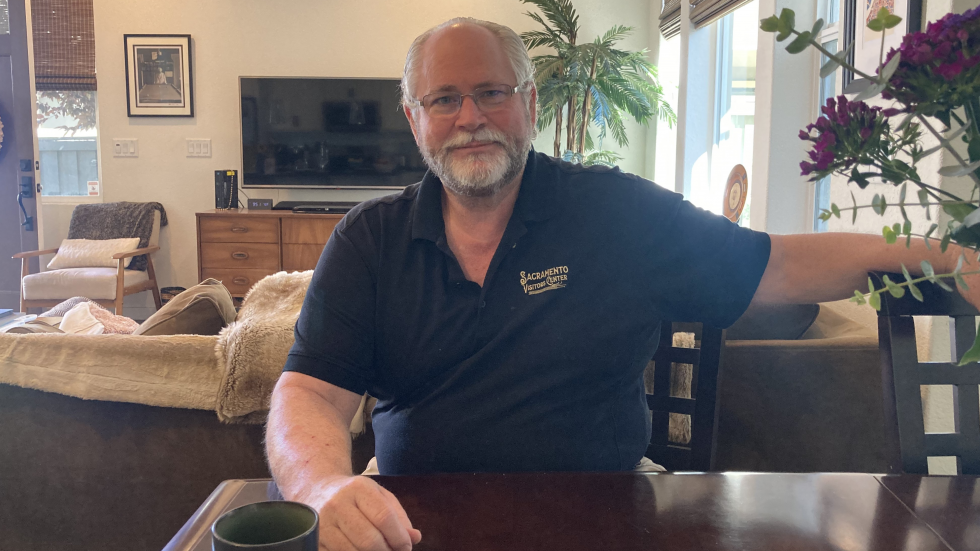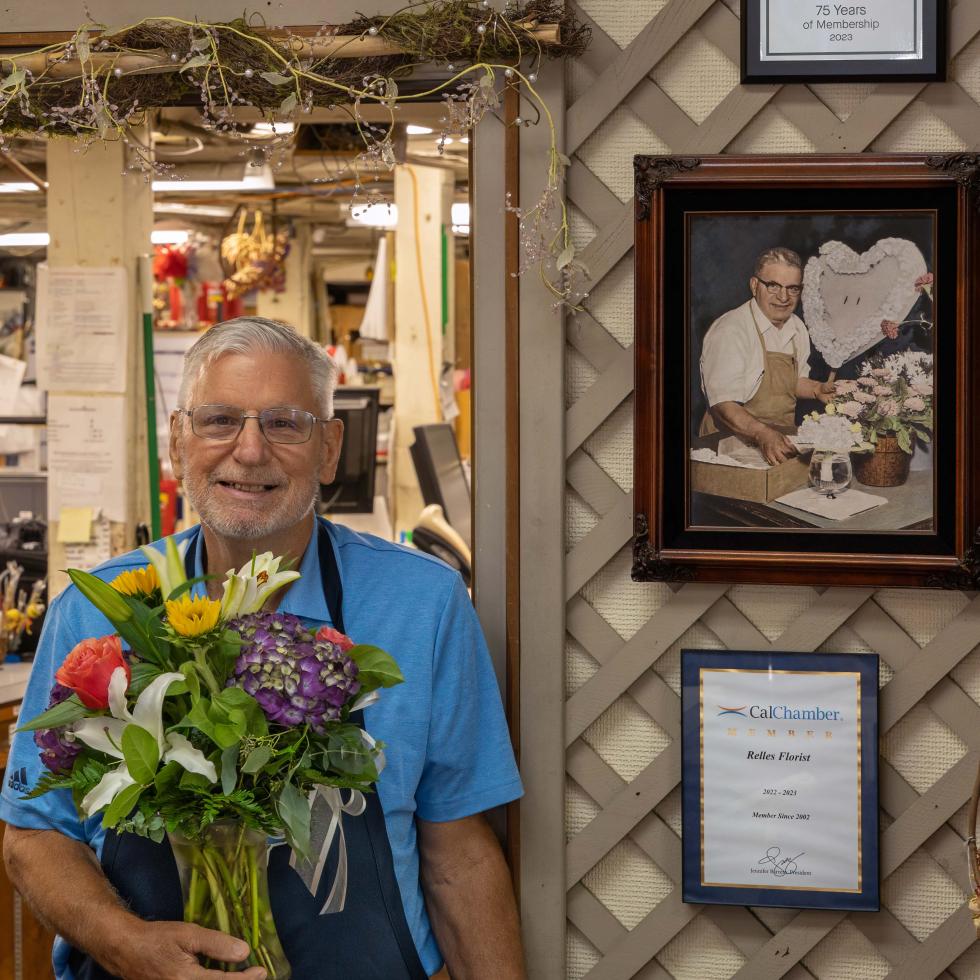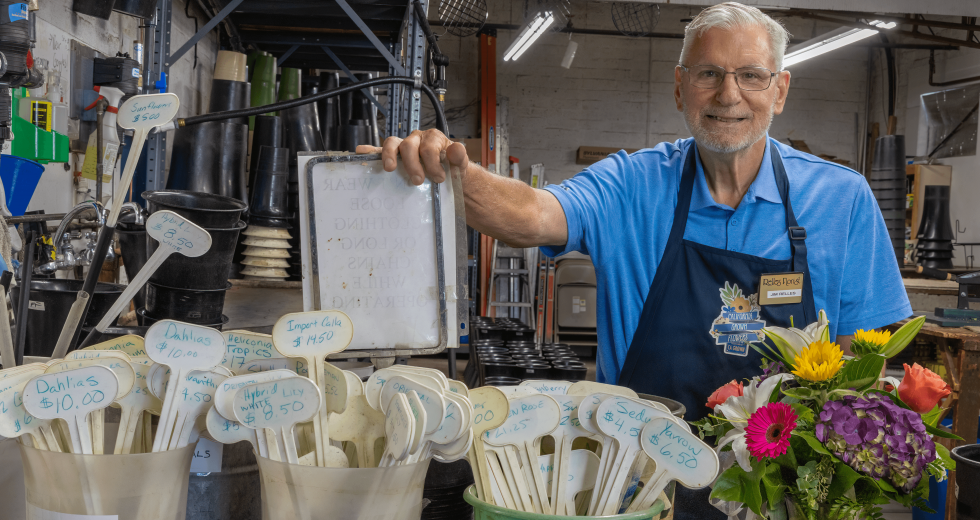Dan Dillon had been retired about two weeks from the Elk Grove Unified School District when he realized he needed something to do.
“Everybody’s different,” says Dillon, 70. “Like my brother, he’s retired. And he goes kayaking, fly fishing and windsurfing. And he’s always going to Hawaii, Tahoe, Baja California. He keeps so busy. I was never that person.”
Dan Dillon, 70, works part-time as an interpretive guide for the
Sacramento Visitors Center. (Photo by Graham Womack)

Instead he now works part-time as an interpretive guide for the Sacramento Visitors Center, answering questions for people from places as far away as Libya, Sudan and Ukraine. He also gives historical tours playing his great-grandfather, an Irish emigrant named Patrick Riley who was born in 1819, ran a freighting business during the Gold Rush, and eventually bought a quarter block in Sacramento next to Peter Hardeman Burnett, California’s first governor.
Dillon is part of a growing cohort: people over the age of 65 who are still in the workforce. The numbers of these workers have grown dramatically in recent decades, nearly tripling between 1988 and 2018, according to the United States Bureau of Labor Statistics.
Some work in search of a second chapter professionally. Others are still in the workforce because they have to be, following economic disasters like the dot-com crash, the Great Recession or other factors such as rising inflation wreaking havoc on retirement savings and budgets. Still others, like Dillon, just need something to do — and many find that work rewarding.
Staying on the job
Jim Relles, 75, is in his 51st year running Relles Florist, founded by his father Ross Relles. His 44-year-old son Colby Relles is training to take over. “I think eventually I’m going to probably totally retire, let him run the business,” Jim Relles says, but adds that “as long as I could be beneficial to him, I’ll probably stick around.”
Other seniors could be saying the same, with the BLS reporting in 2021 that the workforce of people over the age of 75 was likely to grow 96.5 percent by 2030. The BLS has also noted that workers over the age of 65 could comprise 8.6 percent of the labor force by the year 2026.
Some of this could be due to the sheer numbers of senior citizens in America these days. Carol Sewell, who is the policy director for the California Elder Justice Coalition and teaches a gerontology course at Sacramento State, notes that older adults will soon comprise 20 percent of the population.
Jim Relles stands at the entrance to the work area next to a
portrait of his father, Ross Relles Sr., who founded the shop in
Oct. 1946. (Photo by Joe Perfecto)

It can be difficult sometimes for seniors to get hired, Sewell says, due to misconceptions such as older workers being slower and not able to learn. There are positives in hiring them, though, she notes.
“Older workers, they don’t have to learn how to be in the workplace,” Sewell says. “They are consistent, they’re steady, they are full of a wealth of experience. They have a lot to bring to a workplace.”
Post-retirement employment also offers a variety of benefits to workers, not least of which include extra funds. Dillon says he and his wife can cover their bills with his retirement savings and Social Security payouts. But around the time he retired in 2015 at 62, his two daughters were attending college.
“Every five seconds when you’re in college, you need $100 for this and $1,000 for books,” Dillon says. “I said, ‘I can get a retirement job, and I can help the girls out.’”
It’s not to say that having to work well into senior citizenship is all peachy. Those who continue to work might face elevated levels of stress and have to contend with spending less time with loved ones such as grandchildren.
Still, there are other benefits of continuing to work, such as that it can help a person to feel useful and even maintain their mental acuity. USA Today noted in 2013 that a study found each additional year a person works can reduce their risk of dementia by 3.2 percent. There are also the health benefits, according to Antonio Negrete, a 71-year-old senior recreation aide for the City of Sacramento.
“A lot of couch potatoes, before you know it, they have some sort of illness, and I hear they’re in the hospital and, boom, they’re gone,” Negrete says.
Helping seniors
Before he retired at age 60, Negrete was an auditor for the State of California, helping audit major utilities like Pacific Gas & Electric Company to the tune of about $17 million findings.
Now, he helps provide adult daycare services in a building behind Woodlake Elementary School. The people Negrete helps are often in the early stages of dementia. On a typical morning, he’ll talk with them about their lives.
“Sometimes, I start with a simple subject, something like, ‘Do you remember your first kiss?’” Negrete says. “Some people go, ‘Oh God, I remember the first kiss, but I don’t remember who it was.’”
The seniors sometimes forget whether or not they have eaten lunch; the staff use cell phones to record their meals so they can play the videos back to them if they ask. But these same adults better remember bits of their lives from the 1930s or ‘40s.
“We’ll put on a Frank Sinatra song, and all these memories start like a floodgate for them,” Negrete says.
For Negrete, his work is motivated in part by care he helped provide to his late mother, who had bipolar disorder and later dementia. He doesn’t need the money, socking away what he earns in a CalSavers account in the hopes of helping put his niece through law school. “We need a lawyer in the family,” he says.
Others might be working as a symptom of the United States’ decaying safety net for seniors. And it could get worse. Politicians sometimes debate cuts to Social Security benefits, with the program’s reserves projected to become exhausted in 2037.
Even Dillon, who grew up in Sacramento, intends to eventually move with his wife to Tennessee to find a state with lower living costs. That said, his work days might not be finished when he heads east. He’s interested in getting involved with the National Civil Rights Museum in Memphis, behind the former Lorraine Motel where Martin Luther King Jr. was assassinated in 1968. It’s a well-done museum, one that should “be required for every third grader in the country,” Dillon says. And he really doesn’t mind continuing to work as he gets older.
“When you’re younger, you’re trying to do 40 hours worth of stuff in 24 hours, but when you’re 70, you’re only trying to do six or seven hours worth of stuff in a 24-hour day,” Dillon says. “So it’s fun to go to work.”
Stay up to date on business in the Capital Region: Subscribe to the Comstock’s newsletter today.
Recommended For You

Is It All Good?
Why is ‘good’ such a popular word among brands in the Capital Region and beyond?
Feeling good lately? Does the country, the world, seem good? With
a divided electorate, a multiply indicted candidate, the dregs of
a pandemic swirling through our psyches, and the hottest summer
on record, sometimes it’s hard to find the good.

Mud, Music and the Man
A Sacramento Burner shares thoughts on the community spirit of this year’s rainy Burning Man
While reporters and commentators struggled to understand why
73,000 would choose to isolate — and unintentionally strand —
themselves in the desert, Burners lived out the experiment Black
Rock City was built for.

History Speeds on at the West’s Oldest Running Racetrack
Historic Stockton 99 Speedway keeps the racing dream alive in San Joaquin County
The roar of auto engines and the smell of gasoline, hot dogs,
barbecue and beer have marked summer Saturday nights at
the Stockton 99 Speedway since 1947 at the oldest
running racetrack west of the Mississippi.

Sacramento’s Sol Blume Music Fest Is Back in the Sun
A rescheduled Sol Blume sets new attendance record
After torrential rains hit the Capital Region early in 2023, flooding out Discovery Park, organizers of the upcoming Sol Blume festival planned there for April 29-30 had some decisions to make.



